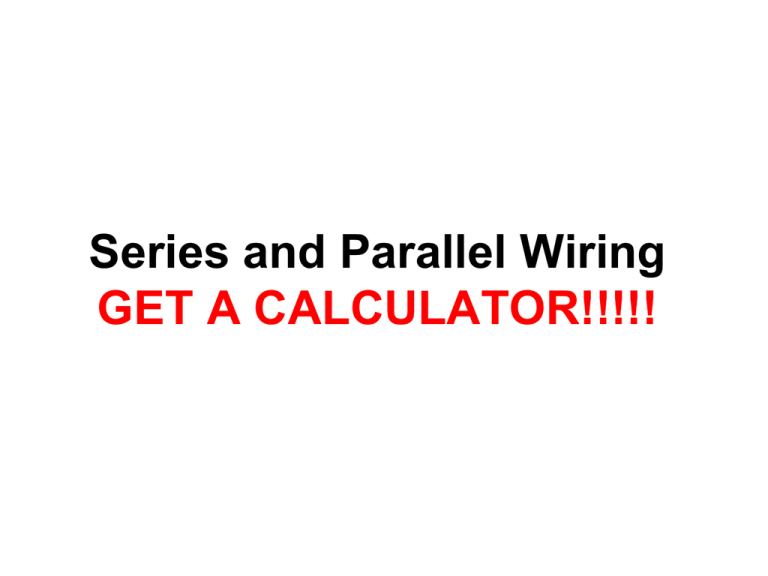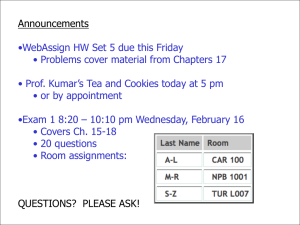Electric Current and Circuits
advertisement

Series and Parallel Wiring GET A CALCULATOR!!!!! SERIES CIRCUITS The same current through each resistor. EQUIVALENT RESISTANCE: What is the net resistance? What one resistor could replace a group of resistors? For resistors wired in series, the equivalent resistance is given by: Req = R1 + R2 + R3 + … PARALLEL CIRCUIT Same voltage across each resistor. For resistors wired in parallel, the equivalent resistance is given by: 1 1 1 1 ... R eq R1 R 2 R 3 Example: What is the equivalent resistance of a 10 W, 20 W, and 30 W resistor wired in series? In parallel? Series: Req = 10 W + 20 W + 30 W = 60 W Parallel 1 / Req = 1/10 W + 1/20 W + 1/30 W Req = 5.45 W There’s much less resistance if resistors are wired in parallel than if they’re wired in series. With less resistance, the charge pump will able to push much more current around the circuit. Circuits and Ohm’s Law: V = IR Series: Req = 10 W + 20 W + 30 W = 60 W Parallel 1 / Req = 1/10 W + 1/20 W + 1/30 W Req = 5.45 W If the circuits were supplied 12 V by a battery, what is the current in the series circuit? I = V/R I = 12 V / 60 W 0.2 A In the parallel circuit? I = V / R = 12 V / 5.45 W 2.2 A In a circuit with 3 light bulbs wired in series, if the current in the first bulb is 0.12 A, what is the current in the 2nd bulb? In the 3rd bulb? The current is the same for all resistors wired in series to each other! If the circuit is supplied 9 V from a battery and the voltage across the 1st bulb is 1 V and across the 2nd bulb is 6 V, what is the voltage across the 3rd bulb? In a series circuit, the sum of voltages across each resistor is equal to the voltage across the whole circuit! Ohm’s Law V = IR A 6 W and a 4 W resistor are wired in parallel across a 9 V battery. Determine the current in the circuit. - First find the equivalent resistance, then the current. R = 2.4 W I=V/R I = 3.75 A How much current goes through the 6 W resistor? - Resistors in parallel have the same voltage (pressure) across them, even if they have different resistance. I=V/R I = 9 V / 6 W = 1.5 A How much current goes through the 4 W resistor? I = 9 V / 4 W = 2.25 A Characteristics of Series and Parallel Wiring Series: If one component goes out, They all go out! As more resistors are added, the equivalent resistance Increases! which means that the current in that part of the circuit Decreases! Parallel: If one component goes out, The rest still work! As more resistors are added, the equivalent resistance Decreases! which means that the current in that part of the circuit Increases! For maximum resistance- use series wiring. For minimum resistance- use parallel wiring. The flow of water is a very good analogy to the flow of charges in both series and parallel circuits. Schematic diagrams symbols to represent circuit components. wires: Charge pumps: Resistors: Switches: Ground: All devices connected to a circuit (light bulbs, TV’s, toasters, etc.) resist the flow of charges and are sometimes drawn as a resistor in the circuit (if you’re considering the unit as a whole). For resistors wired “in series” the same current flows through each one, however the potential difference, voltage, is additive Voltage gain through battery = Sum of Voltage drop through resistors For resistors wired “in parallel”, the potential difference, voltage, is the same for each of them, however the current is additive. Total Current pushed by battery = Sum of Current going through all the resistors








